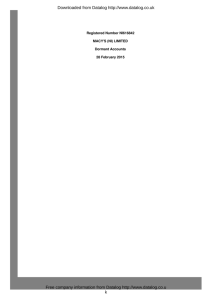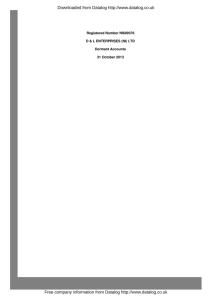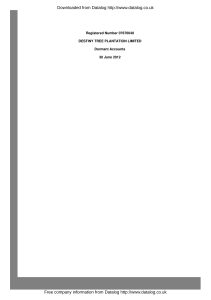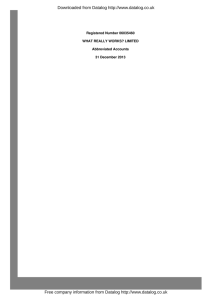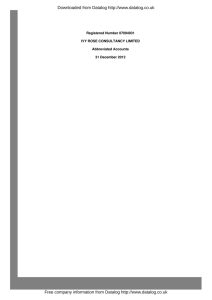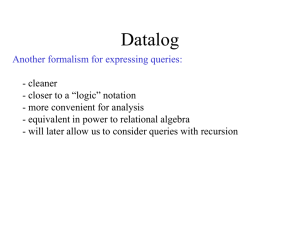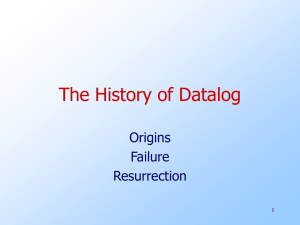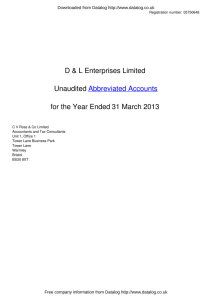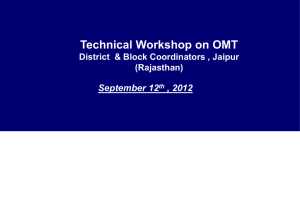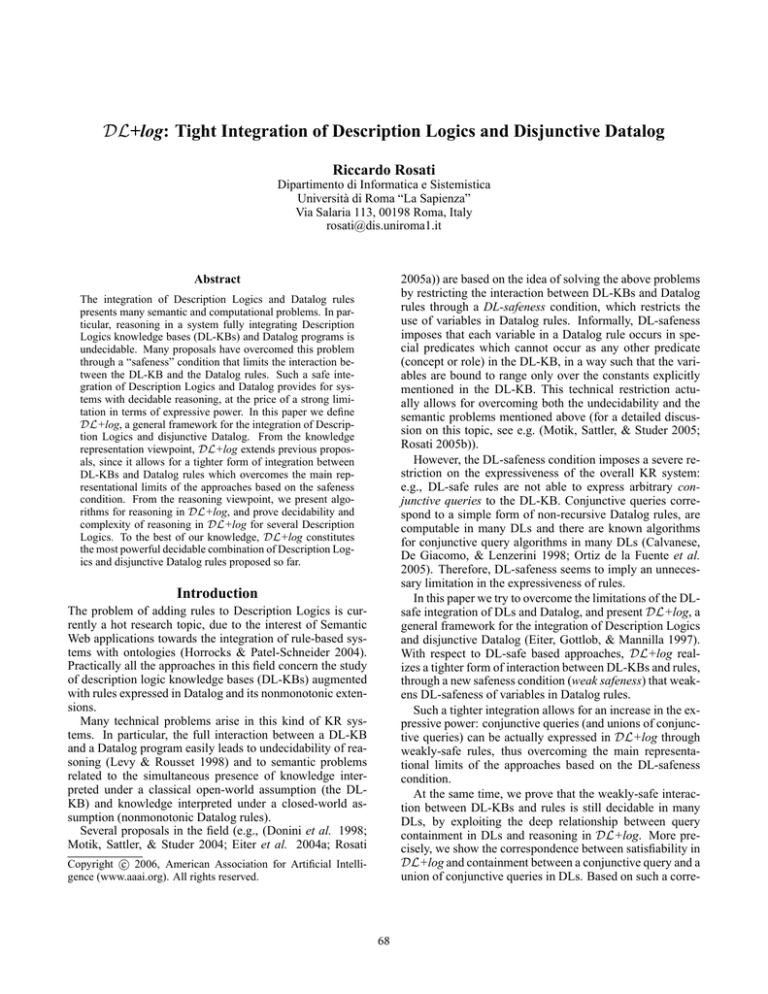
DL+log: Tight Integration of Description Logics and Disjunctive Datalog
Riccardo Rosati
Dipartimento di Informatica e Sistemistica
Università di Roma “La Sapienza”
Via Salaria 113, 00198 Roma, Italy
rosati@dis.uniroma1.it
Abstract
2005a)) are based on the idea of solving the above problems
by restricting the interaction between DL-KBs and Datalog
rules through a DL-safeness condition, which restricts the
use of variables in Datalog rules. Informally, DL-safeness
imposes that each variable in a Datalog rule occurs in special predicates which cannot occur as any other predicate
(concept or role) in the DL-KB, in a way such that the variables are bound to range only over the constants explicitly
mentioned in the DL-KB. This technical restriction actually allows for overcoming both the undecidability and the
semantic problems mentioned above (for a detailed discussion on this topic, see e.g. (Motik, Sattler, & Studer 2005;
Rosati 2005b)).
However, the DL-safeness condition imposes a severe restriction on the expressiveness of the overall KR system:
e.g., DL-safe rules are not able to express arbitrary conjunctive queries to the DL-KB. Conjunctive queries correspond to a simple form of non-recursive Datalog rules, are
computable in many DLs and there are known algorithms
for conjunctive query algorithms in many DLs (Calvanese,
De Giacomo, & Lenzerini 1998; Ortiz de la Fuente et al.
2005). Therefore, DL-safeness seems to imply an unnecessary limitation in the expressiveness of rules.
In this paper we try to overcome the limitations of the DLsafe integration of DLs and Datalog, and present DL+log, a
general framework for the integration of Description Logics
and disjunctive Datalog (Eiter, Gottlob, & Mannilla 1997).
With respect to DL-safe based approaches, DL+log realizes a tighter form of interaction between DL-KBs and rules,
through a new safeness condition (weak safeness) that weakens DL-safeness of variables in Datalog rules.
Such a tighter integration allows for an increase in the expressive power: conjunctive queries (and unions of conjunctive queries) can be actually expressed in DL+log through
weakly-safe rules, thus overcoming the main representational limits of the approaches based on the DL-safeness
condition.
At the same time, we prove that the weakly-safe interaction between DL-KBs and rules is still decidable in many
DLs, by exploiting the deep relationship between query
containment in DLs and reasoning in DL+log. More precisely, we show the correspondence between satisfiability in
DL+log and containment between a conjunctive query and a
union of conjunctive queries in DLs. Based on such a corre-
The integration of Description Logics and Datalog rules
presents many semantic and computational problems. In particular, reasoning in a system fully integrating Description
Logics knowledge bases (DL-KBs) and Datalog programs is
undecidable. Many proposals have overcomed this problem
through a “safeness” condition that limits the interaction between the DL-KB and the Datalog rules. Such a safe integration of Description Logics and Datalog provides for systems with decidable reasoning, at the price of a strong limitation in terms of expressive power. In this paper we define
DL+log, a general framework for the integration of Description Logics and disjunctive Datalog. From the knowledge
representation viewpoint, DL+log extends previous proposals, since it allows for a tighter form of integration between
DL-KBs and Datalog rules which overcomes the main representational limits of the approaches based on the safeness
condition. From the reasoning viewpoint, we present algorithms for reasoning in DL+log, and prove decidability and
complexity of reasoning in DL+log for several Description
Logics. To the best of our knowledge, DL+log constitutes
the most powerful decidable combination of Description Logics and disjunctive Datalog rules proposed so far.
Introduction
The problem of adding rules to Description Logics is currently a hot research topic, due to the interest of Semantic
Web applications towards the integration of rule-based systems with ontologies (Horrocks & Patel-Schneider 2004).
Practically all the approaches in this field concern the study
of description logic knowledge bases (DL-KBs) augmented
with rules expressed in Datalog and its nonmonotonic extensions.
Many technical problems arise in this kind of KR systems. In particular, the full interaction between a DL-KB
and a Datalog program easily leads to undecidability of reasoning (Levy & Rousset 1998) and to semantic problems
related to the simultaneous presence of knowledge interpreted under a classical open-world assumption (the DLKB) and knowledge interpreted under a closed-world assumption (nonmonotonic Datalog rules).
Several proposals in the field (e.g., (Donini et al. 1998;
Motik, Sattler, & Studer 2004; Eiter et al. 2004a; Rosati
c 2006, American Association for Artificial IntelliCopyright °
gence (www.aaai.org). All rights reserved.
68
A a Datalog¬∨ program is a set of Datalog¬∨ rules. If, for
all R ∈ P, n ≤ 1, P is called a Datalog¬ program. If, for
all R ∈ P, h = 0, P is called a positive disjunctive Datalog
program. If, for all R ∈ P, n ≤ 1 and h = 0, P is called
a positive Datalog program. If there are no occurrences of
variable symbols in P, P is called a ground program.
spondence, we provide algorithms for reasoning in DL+log.
To the best of our knowledge, DL+log constitutes the
most powerful decidable combination of Description Logics and disjunctive (nonmonotonic) Datalog rules proposed
so far, and one of the most powerful approaches among the
decidable combinations of DLs and positive recursive Datalog rules. The only approach in this last class that we know
of and that is not subsumed by DL+log is role-safe recursive CARIN (Levy & Rousset 1998), which is uncomparable
with DL+log.
The paper is structured as follows. In the next section, we
define the framework of DL+log for the integration of DLs
and rules. Then, we study reasoning in DL+log, and define
an algorithm for satisfiability in DL+log. In the subsequent
section, we address decidability and complexity of reasoning in DL+log. Finally, we briefly discuss related work and
draw some conclusions. Due to space limits, proofs of theorems are omitted in the present version of the paper.
Definition 1 Given a description logic DL, a DLknowledge base with weakly-safe Datalog¬∨ rules
(DL+log-KB for short) B is a pair (K, P), where:
• K is a DL-KB, i.e., a pair (T , A) where T is the TBox
and A is the ABox (Baader et al. 2003);
• P is a set of Datalog¬∨ rules, where each rule R has the
form
p1 (X1 )∨ . . . ∨ pn (Xn ) ←
r1 (Y1 ), . . . , rm (Ym ), s1 (Z1 ), . . . , sk (Zk ),
not u1 (W1 ), . . . , not uh (Wh )
such that n ≥ 0, m ≥ 0, k ≥ 0, h ≥ 0, each pi (Xi ),
ri (Yi ), si (Zi ), ui (Wi ) is an atom and:
– each pi is either a DL-predicate or a Datalog predicate;
– each ri , ui is a Datalog predicate;
– each si is a DL-predicate;
– (Datalog safeness) every variable occurring in
R must appear in at least one of the atoms
r1 (Y1 ), . . . , rm (Ym ), s1 (Z1 ), . . . , sk (Zk );
– (weak safeness) every head variable of R must appear
in at least one of the atoms r1 (Y1 ), . . . , rm (Ym ).
DL+log
The framework of DL+log, i.e., DL-KBs with weaklysafe disjunctive Datalog (Datalog¬∨ ) rules, that we introduce in this section, constitutes an extension of DL-log,
originally proposed in (Rosati 1999) and then extended to
the framework of r-hybrid KBs presented in (Rosati 2005a;
2005b). We thus refer to (Rosati 2005a) for more details
about the general framework. In the following, we assume
that the reader is familiar with the basics of Description Logics (Baader et al. 2003).
We remark that the above notion of weak safeness allows
for the presence of variables that only occur in DL-atoms
in the body of R. On the other hand, the notion of DLsafeness of variables adopted in previous approaches (Rosati
1999; Motik, Sattler, & Studer 2005; Rosati 2005a) can be
expressed as follows: every variable of R must appear in
at least one of the atoms r1 (Y1 ), . . . , rm (Ym ). Therefore,
DL-safeness forces every variable of R to occur also in the
Datalog atoms in the body of R, while weak safeness allows
for the presence of variables that only occur in DL-atoms in
the body of R.
Without loss of generality, in the rest of the paper we assume that in a DL+log-KB (K, P) all constants occurring
in K also occur in P.
Syntax
We start from three mutually disjoint predicate alphabets:
• an alphabet of concept names ΣC ;
• an alphabet of role names ΣR ;
• an alphabet of Datalog predicates ΣD .
We call a predicate p a DL-predicate if either p ∈ ΣC or
p ∈ ΣR . Then, we denote by C a countably infinite alphabet
of constant names.
An atom is an expression of the form p(X), where p is
a predicate of arity n and X is a n-tuple of variables and
constants. If no variable symbol occurs in X, then p(X) is
called a ground atom (or fact). If p ∈ ΣC ∪ ΣR , the atom
is called a DL-atom, while if p ∈ ΣD , it is called a Datalog
atom.
We recall (see (Eiter, Gottlob, & Mannilla 1997)) that a
Datalog¬∨ rule R is an expression of the form
First-order semantics
The interpretation of constants is according to the standard
names assumption:1 every first-order interpretation is over
the same fixed, countably infinite, domain ∆, and in addition, the alphabet of constants C is such that it is in the same
one-to-one correspondence with ∆ in every interpretation:
that is, there is a constant symbol for each element of ∆,
each constant denotes the same element of ∆ in every interpretation, and two distinct constants denote two distinct
elements (this last property is known as the unique name assumption).
p1 (X 1 ) ∨ . . . ∨ pn (Xn ) ←
r1 (Y1 ), . . . , rm (Ym ), not u1 (W1 ), . . . , not uh (Wh )
such that n ≥ 0, m ≥ 0, h ≥ 0, each pi (Xi ), ri (Yi ),
ui (Wi ) is an atom and every variable occurring in R must
appear in at least one of the atoms r1 (Y1 ), . . . , rm (Ym ).
This last condition is known as the Datalog safeness condition for variables. The variables occurring in the atoms
p1 (X1 ), . . . , pn (Xn ) are called the head variables of R. If
n = 0, we call R a constraint.
1
For motivation and details on the standard names assumption
in this setting, see (Rosati 2005a; 2005b).
69
Informally, the projection of Pg with respect to I corresponds to evaluating Pg with respect to I, thus eliminating from Pg every atom whose predicate is interpreted in
I. Thus, when Σ0 = ΣC ∪ ΣR , all occurrences of DLpredicates are eliminated in the projection of Pg with respect
to I, according to the evaluation in I of the atoms with DLpredicates occurring in Pg .
Given two interpretations I, I 0 of the set of predicates Σ,
we write I 0 ⊂Σ I if
0
1. for each p ∈ Σ, pI ⊆ pI , and
In the following, when we speak about satisfiability and
query containment in DLs, we will refer to these notions
under the above semantic assumption.
Let R be the following Datalog¬∨ rule:
R = p1 (X1 , c1 ) ∨ . . . ∨ pn (Xn , cn ) ←
r1 (Y1 , d1 ), . . . , rm (Ym , dm ),
s1 (Z1 , e1 ), . . . , sk (Zk , ek ),
not u1 (W1 , f1 ), . . . , not uh (Wh , fh )
(1)
where each Xi , Yi , Zi , Wi is a set of variables and each ci ,
di , ei , fi is a set of constants. Then, FO(R) is the first-order
sentence
0
2. there exists p ∈ Σ such that pI ⊂ pI .
In words, I 0 ⊂Σ I if the extension of the predicates of Σ in
I is strictly larger than in I 0 .
Given a positive ground Datalog¬∨ program P over an
alphabet of predicates Σ and an interpretation I, we say that
I is a minimal model of P if I satisfies FO(P) and there is
no interpretation I 0 such that I 0 satisfies FO(P) and I 0 ⊂Σ
I.
Given a ground Datalog¬∨ program P and an interpretation I for P, the GL-reduct (Gelfond & Lifschitz 1991) of
P with respect to I, denoted by GL(P, I), is the positive
ground program obtained from P as follows. For each rule
R ∈ P:
1. delete R if there exists a negated atom not r(t) in the body
of R such that t ∈ rI ;
2. delete each negated atom not r(t) in the body of R such
that t 6∈ rI .
Given a ground Datalog¬∨ program P and an interpretation
I, I is a stable model for P iff I is a minimal model of
GL(P, I).
∀x1 , . . . , xn , y 1 , . . . , y m , z 1 , . . . , z k , w1 , . . . , wh .
r1 (y 1 , d1 ) ∧ . . . ∧ rm (y m , dm )∧
s1 (z 1 , e1 ) ∧ . . . ∧ sk (z k , ek )∧
¬u1 (w1 , f1 ) ∧ . . . ∧ ¬uh (wh , fh ) →
p1 (x1 , c1 ) ∨ . . . ∨ pn (xn , cn )
Given a Datalog¬∨ program P, FO(P) is the set of firstorder sentences {FO(R) | R ∈ P}.
Moreover, given a DL-KB K, we denote by FO(K) the
first-order theory obtained by the standard translation of DLs
into FOL (see e.g. (Baader et al. 2003) for details).
A FOL-model of a DL+log-KB B = (K, P) is an interpretation I of ΣC ∪ ΣR ∪ ΣD such that I satisfies
FO(K) ∪ FO(P). B is called FOL-satisfiable if it has at
least a FOL-model. A ground atom p(c) is FOL-entailed by
B iff, for each FOL-model I of B, I satisfies p(c).
Notice that the above first-order semantics of rules does
not distinguish between negated atoms in the body and disjunction in the head of rules: e.g., according to such semantics, the rules A ← B, not C and A ∨ C ← B have the same
meaning.
Definition 2 An interpretation I of ΣC ∪ΣR ∪ΣD is a NMmodel for B = (K, P) if the following conditions hold:
1. IΣC ∪ΣR satisfies K;
2. IΣD is a stable model for Π(gr(P, C), IΣC ∪ΣR ).
B is called NM-satisfiable if B has at least a NM-model.
Nonmonotonic semantics
Given an interpretation I and a predicate alphabet Σ, we
denote by IΣ the projection of I to Σ, i.e., IΣ is obtained
from I by restricting it to the interpretation of the predicates
in Σ.
Given a set of constants C, the ground instantiation of P
with respect to C, denoted by gr(P, C), is the program obtained from P by replacing every rule R in P with the set
of rules obtained by applying all possible substitutions of
variables in R with constants in C.
Given an interpretation I of an alphabet of predicates
Σ0 ⊂ Σ, and a ground program Pg over the predicates in Σ,
the projection of Pg with respect to I, denoted by Π(Pg , I),
is the ground program obtained from Pg as follows. For
each rule R ∈ Pg :
We say that a ground atom p(c) is NM-entailed by B iff,
for each NM-model I of B, I satisfies p(c).
According to the NM semantics, DL-predicates are
still interpreted under the classical open-world assumption
(OWA), while Datalog predicates are interpreted under a
closed-world assumption (CWA) (see (Rosati 2005b) for a
detailed discussion of this aspect).
Notice that, both under the FOL semantics and the NM
semantics, entailment can be reduced to satisfiability, since
it is possible to express constraints in the Datalog program.
More precisely, under both semantics, it is immediate to verify that (K, P) entails p(c) iff (K, P ∪ {← p(c)}) is unsatisfiable. In a similar way, it can be seen that conjunctive query
answering can be reduced to satisfiability in DL+log (see
the discussion section). Consequently, in the following we
concentrate on the satisfiability problem in DL+log-KBs.
• delete R if there exists an atom r(t) in the head of R such
that r ∈ Σ0 and t ∈ rI ;
• delete each atom r(t) in the head of R such that r ∈ Σ0
and t 6∈ rI ;
• delete R if there exists an atom r(t) in the body of R such
that r ∈ Σ0 and t 6∈ rI ;
Relationship between FOL and NM semantics
• delete each atom r(t) in the body of R such that r ∈ Σ0
and t ∈ rI ;
We now show that, when the rules are positive disjunctive,
i.e., there are no negated atoms in the bodies of rules, the
70
Example 6 Let B = (K, P) be the DL+log knowledge
base reported in Figure 2.
For the reader unfamiliar with the DL syntax, we recall
that the meaning of the first the first assertion of the DL-KB
K is expressed by the first-order logic sentence
above two semantics are equivalent with respect to the satisfiability problem.
Theorem 3 Let B = (K, P) be a DL+log-KB, where P is a
positive disjunctive Datalog program. B is FOL-satisfiable
iff B is NM-satisfiable.
∀x.RICH(x) ∧ UNMARRIED(x) →
∃y.WANTS-TO-MARRY(y, x)
Moreover, given a rule R of the form (1), we denote by
τ (R) the rule obtained from R by moving every negated
atom in the body of R to the rule head. Formally:
It can be easily verified that all NM-models for B satisfy
the following formulas:
τ (R) = p1 (X1 , c1 ) ∨ . . . ∨ pn (Xn , cn )∨
u1 (W1 , f1 ) ∨ . . . ∨ uh (Wh , fh ) ←
r1 (Y1 , d1 ), . . . , rm (Ym , dm ),
s1 (Z1 , e1 ), . . . , sk (Zk , ek )
• RICH(Paul) and RICH(Mary), since the default rule R2 is
always applicable for X = Paul and X = Mary, but not
for X = Joe, since the fact scientist(Joe) holds in every
model for B;
• ∃WANTS-TO-MARRY− .>(Mary), due to the first axiom
of the DL-KB and to the fact that both RICH(Mary)
and UNMARRIED(Mary) hold in every model of the
DL+log-KB B (while ∃WANTS-TO-MARRY− .>(Paul) is
not forced by such axiom to hold in every model of B, because UNMARRIED(Paul) is not forced to hold in every
such model);
• happy(Mary), due to the above conclusions and to the
rule R1. Indeed, since ∃WANTS-TO-MARRY− .>(Mary)
holds in every model of B, it follows that in
every model there exists a constant x such that
WANTS-TO-MARRY(x, Mary) holds in the model, consequently from rule R1 it follows that happy(Mary) also
holds in the model.
Theorem 4 Let B = (K, P) be a DL+log-KB. B is FOL0
satisfiable
S iff B = (K, τ (P)) is NM-satisfiable, where
τ (P) = R∈P τ (R).
Therefore, FOL-satisfiability can always be reduced (in
linear time) to NM-satisfiability. Hence, in the following
we concentrate on the satisfiability problem under the NM
semantics.
We conclude this section with two simple examples of
DL+log knowledge bases. In both examples, we denote
DL-predicates by uppercase names, and denote Datalog
predicates by lowercase names.
Example 5 Let B = (K, P) be the DL+log knowledge
base reported in Figure 1, where the DL-KB K defines an
ontology about persons, and the disjunctive Datalog program P defines nonmonotonic rules about students.
For the reader unfamiliar with the DL syntax, we report
the translation of the first four inclusion assertions of the
DL-KB K in terms of sentences in first-order logic:
Notice that, according to the definitions given in the previous section, the variable Y in rule R1 is weakly-safe but not
DL-safe, since Y does not occur in any Datalog predicate in
rule R1.
∀x.PERSON(x) → ∃y.FATHER(y, x) ∧ MALE(y)
∀x.MALE(x) → PERSON(x)
∀x.FEMALE(x) → PERSON(x)
∀x.FEMALE(x) → ¬MALE(x)
Reasoning
In this section we study reasoning in DL+log. In particular,
we study satisfiability for finite DL+log-KBs (as mentioned
above, entailment can be easily reduced to satisfiability in
DL+log).
We start by introducing Boolean conjunctive queries
(CQs) and Boolean unions of conjunctive queries (UCQs),
and the containment problem for such queries. A Boolean
UCQ over a predicate alphabet Σ is a first-order sentence
of the form ∃~x.conj1 (~x) ∨ . . . ∨ conjn (~x), where ~x is a tuple of variable symbols and each conji (~x) is a set of atoms
whose predicates are in Σ and whose arguments are either
constants or variables from ~x. A Boolean CQ corresponds
to a Boolean UCQ in the case when n = 1.
Given a DL-TBox T , a Boolean CQ Q1 and a Boolean
UCQ Q2 over the alphabet ΣC ∪ ΣR , Q1 is contained in Q2
with respect to T , denoted by T |= Q1 ⊆ Q2 , iff, for every
model I of T , if Q1 is satisfied in I then Q2 is satisfied in
I.In the following, we call the problem of deciding T |=
Q1 ⊆ Q2 the Boolean CQ/UCQ containment problem.2
It can be easily verified that all NM-models for B satisfy
the following ground atoms:
• boy(Paul) (since rule R1 is always applicable for X =
Paul and R1 acts like a default rule, which can be read as
follows: if X is a person enrolled in course c1, then X is
a boy, unless we know for sure that X is a girl);
• girl(Mary) (since rule R2 is always applicable for X =
Mary)
• boy(Bob) (since rule R3 is always applicable for X =
Bob, and, by rule R4, the conclusion girl(Bob) is inconsistent with K);
• MALE(Paul) (due to rule R5);
• FEMALE(Mary) (due to rule R4).
Notice that B |=NM FEMALE(Mary), while K 6|=F OL
FEMALE(Mary). In other words, adding rules has indeed an
effect on the conclusions one can draw about DL-predicates.
Moreover, such an effect also holds under the first-order semantics of DL+log-KBs, since it can be immediately verified that in this case B |=F OL FEMALE(Mary).
2
This problem was called existential entailment in (Levy &
Rousset 1998).
71
PERSON v ∃FATHER− .MALE
MALE v PERSON
FEMALE v PERSON
FEMALE v ¬MALE
MALE(Bob)
PERSON(Mary)
PERSON(Paul)
(a) DL-KB K (ontology about persons)
boy(X) ← enrolled(X, c1), PERSON(X), not girl(X) [R1]
girl(X) ← enrolled(X, c2), PERSON(X) [R2]
boy(X) ∨ girl(X) ← enrolled(X, c3), PERSON(X) [R3]
FEMALE(X) ← girl(X) [R4]
MALE(X) ← boy(X) [R5]
enrolled(Paul, c1)
enrolled(Mary, c1)
enrolled(Mary, c2)
enrolled(Bob, c3)
(b) disjunctive Datalog program P (rules about students)
Figure 1: DL+log knowledge base B = (K, P) of Example 5
RICH u UNMARRIED v ∃WANTS-TO-MARRY− .>
UNMARRIED(Mary)
UNMARRIED(Joe)
(a) DL-KB K
happy(X) ← famous(X), WANTS-TO-MARRY(Y, X) [R1]
RICH(X) ← famous(X), not scientist(X) [R2]
famous(Mary)
famous(Paul)
famous(Joe)
scientist(Joe)
(b) disjunctive Datalog program P
Figure 2: DL+log-KB B = (K, P) of Example 6
72
Notice that P(GP , GN ) is a ground Datalog¬∨ program
over ΣD , i.e., no DL-predicate occurs in such a program.
We are now ready to present the algorithm NMSATDL+log for deciding NM-satisfiability of DL+log-KBs.
The algorithm is shown in Figure 3. The algorithm has a
very simple structure, since it decides satisfiability by looking for a guess (GP , GN ) of the Boolean CQs in grp (P) that
is consistent with the DL-KB K and such that the Datalog¬∨
program P(GP , GN ) has a stable model.
Correctness of the algorithm is based on the following
property, which relates consistency of a guess (GP , GN ) of
Boolean CQs with the problem of containment of a Boolean
CQ in a Boolean UCQ with respect to a DL-TBox.
General algorithm
Given a program P, we denote by CP the set of constants
occurring in P.
In the following definition, we assume that a rule R in
P has the form αR (~x) ← βR (~x, ~y , w),
~ γR (~x, ~y , ~z), where
γR (~x, ~y , ~z) is the set of DL-atoms occurring in the body of
R (and, of course, βR (~x, ~y , w)
~ is the set of Datalog atoms
in the body of R), ~x are the head variables in R, ~y are the
existential variables occurring both in DL-atoms and in Datalog atoms in R, and ~z (respectively, w)
~ are the existential
variables of R that only occur in DL-atoms (respectively,
Datalog atoms) in R.
Definition 7 Let B = (K, P) be a DL+log-KB. The DLgrounding of P, denoted by grp (P), is the following set of
Boolean CQs:
Lemma 8 There exists a model M for K = (T , A) such
that every Boolean CQ in GP is satisfied in M and every
Boolean CQ in GN is not satisfied in M if and only if T 6|=
CQ(A ∪ GP ) ⊆ U CQ(GN ).
grp (P) = {γR (~c1 /~x, c~2 /~y , ~z) |
R ∈ P and ~c1 , c~2 are tuples of constants in CP }
∪
{p(~c/~x) |
p is a DL-predicate occurring in a rule head
in P and ~c is a tuple of constants in CP }
Based on the above lemma, we are able to prove correctness of the algorthm NMSAT-DL+log.
Theorem 9 Let B be a DL+log-KB. Then, B is NMsatisfiable iff NMSAT-DL+log(B) returns true.
Notice that grp (P) constitutes a partial grounding of the
conjunctions of DL-atoms that occur in P with respect to
the constants in CP , since the variables that only occur in
DL-atoms in the body of rules are not replaced by constants
in grp (P).
Let G be a set of Boolean CQs. Then, we denote by
CQ(G) the Boolean CQ corresponding to theVconjunction
of all the Boolean CQs in G, i.e., CQ(G) = γ∈G γ. We
also denote by U CQ(G) the Boolean UCQ corresponding
to the disjunction
of all the Boolean CQs in G, namely
W
U CQ(G) = γ∈G γ.3
Similarly to gr(P, CP ), we define the partial grounding of
P on CP (denoted by pgr(P, CP )) as the program obtained
from P by grounding with the constants in CP all variables
except the existential variables of R that only occur in DLatoms.
Finally, given a partition (GP , GN ) of grp (P), we denote
by P(GP , GN ) the ground Datalog¬∨ program obtained
from pgr(P, CP ) by:
Algorithm for DL-lite+log
Then, we provide a specialized method for the description
logic DL-lite (Calvanese et al. 2005): more specifically,
we study the case of DL-lite+log-KBs with positive Datalog rules (we recall that, by Theorem 3, in this case the FOL
semantics and the NM semantics coincide). For such KBs,
we are able to define an algorithm that (instead of guessing
the truth value of the conjunctions in grp (P)) generalizes
the standard bottom-up computation of the minimal model
of a positive Datalog program.
The algorithm is displayed in Figure 4. Basically, at each
iteration, the algorithm applies the rules in pgr(P, CP ): every such rule R is of the form α ← β, γ, where β is the
set of Datalog atoms in the body of R, and γ is the set of
DL-atoms in the body of R. If R is “fired”, i.e., all the facts
in β have already been derived and the Boolean conjunctive
query γ is entailed by the initial DL-lite-KB K augmented
with the DL-atom derived in the previous iterations, then the
atom α (which can be either a DL-atom or a Datalog atom)
is derived. The computation is iterated until a fixpoint is
reached, i.e., no new facts are derived.
Notice that, in order to check whether a rule is fired, the
algorithm has to solve the problem of answering a Boolean
conjunctive query over a DL-lite-KB (i.e., entailment of the
conjuctive query γ wrt the DL-lite-KB (T , AN )). Thus, in
this algorithm we resort to conjunctive query answering (instead of query containment): notably, very efficient algorithms for answering conjunctive queries have been defined
for DL-lite (Calvanese et al. 2005).
• deleting all occurrences of the conjunction γ from the
body of the rules, for each γ ∈ GP ;
• deleting each rule in which γ occurs in the body, for each
γ ∈ GN ;
• deleting each rule in which γ occurs in the head, for each
γ ∈ GP ;
• deleting all occurrences of the conjunction γ from the
head of the rules, for each γ ∈ GN .
3
Without loss of generality, we assume that each γ in G
uses
V different existential variable symbols, so that the expression
γ∈G γ can be immediately turned into a Boolean CQ by factoring
out all existential quantifications (an analogous simple transformation is needed for turning U CQ(G) into a Boolean UCQ).
Theorem 10 Let B = (K, P) be a DL-lite+log-KB such
that P is a positive Datalog program. B is FOL-satisfiable
(or, equivalently, NM-satisfiable) iff SAT-DL-lite+log(B) returns true.
73
Algorithm NMSAT-DL+log(B)
Input: DL+log-KB B = (K, P) with K = (T , A)
Output: true if B is NM-satisfiable, false otherwise
begin
if there exists partition (GP , GN ) of grp (P)
such that
(a) P(GP , GN ) has a stable model and
(b) T 6|= CQ(A ∪ GP ) ⊆ U CQ(GN )
then return true
else return false
end
Figure 3: The algorithm NMSAT-DL+log
Algorithm SAT-DL-lite+log(B)
Input: DL-lite+log-KB B = (K, P) with K = (T , A) DL-lite-KB,
P positive Datalog program with constraints
Output: true if B is satisfiable, false otherwise
begin
AN := A;
EDB := ∅;
repeat
A0 := AN ;
EDB0 := EDB;
for each rule R ∈ pgr(P, CP ) with R = α ← β, γ do
if β ∈ EDB and (T , AN ) |= γ
then if α is empty (i.e., R is a constraint)
then return false
else if α is a DL-atom
then AN := AN ∪ {α}
else EDB := EDB ∪ {α}
until (AN = A0 ) and (EDB = EDB0 );
if (T , AN ) is a consistent DL-lite-KB
then return true
else return false
end
Figure 4: The algorithm SAT-DL-lite+log
74
• if P is a positive Datalog program, then deciding FOLsatisfiability (or, equivalently, NM-satisfiability) of B is
PTIME-complete with respect to data complexity;
• if P is a positive disjunctive Datalog program, then deciding FOL-satisfiability (or, equivalently, NM-satisfiability)
of B is NP-complete with respect to data complexity;
• if P is an arbitrary Datalog¬∨ program, then deciding
NM-satisfiability of B is Σp2 -complete with respect to data
complexity.
Decidability and complexity
First, from the analysis of the algorithm NMSAT-DL+log
presented above, we are able to prove a very general property that states decidability of reasoning in DL+log whenever the Boolean CQ/UCQ containment problem is decidable in DL.
Theorem 11 For every description logic DL, satisfiability
of DL+log-KBs (both under FOL semantics and under NM
semantics) is decidable iff Boolean CQ/UCQ containment is
decidable in DL.
Therefore, in DL-lite, under both semantics, the data complexity does not increase with respect to the data complexity
of the Datalog program alone. In other words, connecting
a DL-lite-KB to a Datalog program does not increase complexity of reasoning in the size of the data. We also point out
that DL-lite with arbitrary, non-weakly-safe recursive Datalog rules is undecidable (which follows from the results in
(Levy & Rousset 1998; Calvanese & Rosati 2003)).
From the above theorem and from previous results on
query answering and query containment in DLs, we are able
to state decidability of reasoning in DL+log in the case
when DL corresponds to several known DLs.
In particular, we observe that, for the description logic
DLR (Calvanese et al. 1998), it is known that Boolean
CQ/UCQ containment is decidable, hence reasoning in
DLR+log-KBs is decidable.
Related work
Theorem 12 Satisfiability of DLR+log-KBs (both under
FOL semantics and under NM semantics) is decidable.
As mentioned above, several recent studies propose various
forms of integration between DLs and rules. The first formal proposals for the integration of Description Logics and
rules are AL-log (Donini et al. 1998) and CARIN (Levy &
Rousset 1996a; 1996b; 1998).
AL-log is a framework which integrates KBs expressed in
the description logic ALC and positive Datalog programs:
the interaction between the DL-KB and the rules is controlled by a syntactic condition that corresponds to the DLsafeness above mentioned, which states that every variable
of a rule R must appear in at least one of the Datalog atoms
occurring in the body of R.
Research in non-safe interaction of DLs and rules was
started by the work on CARIN (Levy & Rousset 1996a;
1996b; 1998), which established very important undecidability results concerning non-safe interaction between DLKBs and rules. Roughly speaking, such results clearly indicate that, in case of unrestricted interaction between DLKBs and rules, decidability of reasoning holds only if at
least one of the two components has very limited expressive power: e.g., in order to retain decidability of reasoning,
allowing recursion in rules imposes very severe restrictions
on the expressiveness of the DL-KB.
Then, DL-log was proposed in (Rosati 1999) as an extension of AL-log, based on the use of Datalog¬∨ instead of
positive Datalog, and on the possibility of using binary predicates (roles) besides unary predicates (concepts) in rules,
while keeping the above DL-safeness condition on variables.
This framework has been further extended in (Rosati 2005a)
to the integration of arbitrary, decidable, first-order theories
and disjunctive Datalog rules based on an analogous notion
of safeness.
The framework of AL-log has been extended in a different way in (Motik, Sattler, & Studer 2004; 2005). There, the
problem of extending OWL-DL with positive Datalog programs is analyzed. The interaction between OWL-DL and
rules is again restricted through the DL-safeness condition
above described. With respect to DL-log, in (Motik, Sattler,
& Studer 2005) a more expressive structural language and
Since DLR is a generalization of many expressive DLs
(Calvanese et al. 1998), this result proves decidability of
adding weakly-safe Datalog¬∨ rules in many DLs.4
For the description logic SHIQ it is known that conjunctive query answering is decidable (see e.g. (Ortiz de la
Fuente et al. 2005)), but decidability of Boolean CQ/UCQ
containment in SHIQ has not been studied yet, therefore
satisfiability in SHIQ+log is still an open problem: however, we conjecture that Boolean CQ/UCQ containment in
SHIQ is decidable as well, and hence that reasoning in
SHIQ+log is decidable.
For DL-lite+log, besides decidability (which is a corollary of Theorem 12 since DLR is a generalization of
DL-lite), we are able to establish the computational complexity of reasoning for different classes of Datalog programs. More precisely, the following theorem refers to
data complexity of satisfiability, which in the framework of
DL+log corresponds to the analysis of the computational
complexity of the problem when we only consider the size
of the ABox A and of the EDB of P, i.e., the set of facts
contained in P. In other words, data complexity considers
the TBox T and the rules not corresponding to facts (i.e., the
IDB) in P as fixed, hence they are not part of the input. Data
complexity is a very significant measure when the size of the
data, i.e., the ABox and the EDB of P, is much larger than
the size of the intensional knowledge, i.e., the TBox and the
IDB of P.
The following results are based on the analysis of the previous algorithms and on the fact that conjunctive query answering in DL-lite is in PTIME in data complexity (actually
it is in LOGSPACE) (Calvanese et al. 2005).
Theorem 13 Let B = (K, P) be a DL-lite+log-KB. Then:
4
The first DL for which it was proved that Boolean CQ/UCQ
containment is decidable is ALCN R, studied in (Levy & Rousset
1998), which actually corresponds to a restricted version of DLR.
75
a less expressive rule language are adopted: moreover, the
information flow is bidirectional, i.e., structural predicates
may appear in the head of rules.
The work presented in (Grosof et al. 2003) can also be
seen as an approach based on a form of safe interaction between the structural DL-KB and the rules: in particular, a
rule language is defined such that it is possible to encode
a set of rules into a semantically equivalent DL-KB. As a
consequence, such a rule language is very restricted.
Another approach for extending DLs with Datalog¬ rules
is presented in (Eiter et al. 2004a; 2004b). Differently from
DL+log and from the other approaches above described,
this proposal allows for specifying in rule bodies queries to
the structural component, where every query also allows for
specifying an input from the rule component, and thus for an
information flow from the rule component to the structural
component. The meaning of such queries in rule bodies is
given at the meta-level, through the notion of skeptical entailment in the DL-KB. In particular, a condition equivalent
to the DL-safeness on variables is imposed at the semantic
level (rather than by the syntax), since the meaning of every
rule correspond to the grounding of such rule over the constants occurring in the program. Thus, from the semantic
viewpoint, this form of interaction-via-entailment between
the DL-KB and the rules is more restricted than the interaction provided by DL+log. On the other hand, such an
increased separation in principle allows for more modular
reasoning techniques, which are able to completely separate
reasoning about the DL-KB and reasoning about rules.
Finally, another recent proposals in this field is SWRL
(Horrocks & Patel-Schneider 2004), a non-safe approach to
the integration of rules and DL-KBs in which rules are interpreted under the classical FOL semantics. The addition of
this kind of rules to DLs leads to undecidability of reasoning.
conjunctive queries:
q = ∃x, y, z. C(x), R(x, y), C(y), R(y, z), C(z), R(z, x)
∨ D(x), S(x, y), T (y, x)
The query q can be correctly formalized by the following
program P consisting of the following weakly-safe rules:
← C(X), R(X, Y ), C(Y ), R(Y, Z), C(Z), R(Z, X)
← D(X), S(X, Y ), T (Y, X)
Indeed, it is immediate to see that K |= q iff (K, P) is unsatisfiable. Notice that the above rules are weakly-safe (and
hence expressible in DL+log) but not DL-safe: to satisfy
DL-safeness, one should force, in each rule, all the existential variables to occur in auxiliary atoms which restrict
such variables to range only on the constants explicitly mentioned in the ABox, thus changing the meaning of the original query q.
On the other hand, it can be shown that, in the case of
(non-Boolean) CQs and UCQs with head variables, the safeness condition on the head variables does not actually affect
the meaning of such queries, since it is commonly assumed
that the answers returned by queries must be tuples of constants occurring in the DL-KB. Therefore, CQs and UCQs
over DL-KBs can be correctly represented as weakly-safe
rules in DL+log.
From the reasoning viewpoint, we have proved that in
DL+log we can actually define reasoning techniques in a
way in principle similar to what has been done in the case of
DL-safe rules (Motik, Sattler, & Studer 2005; Rosati 2005a).
However, in DL+log it is harder to arrive at a separation
between rules and DL-KB in the reasoning process, in the
following sense:
• In the presence of DL-safe rules, the separation can be
done by using essentially the traditional reasoning services offered by DL-KBs, in particular, KB satisfiability.
Discussion
• For DL+log, it turns out that we can separate rules from
the DL-KB only if the DL-component offers a query containment reasoning service.5
The present work aims at extending the integration of DLs
and Datalog based on the DL-safeness condition recalled
in the previous section, which is actually adopted (although through different formal assumptions) by many of
the proposals previously mentioned (Donini et al. 1998;
Eiter et al. 2004a; Motik, Sattler, & Studer 2005; Rosati
2005a).
From the viewpoint of the expressive power, DL+log
provides a significant improvement with respect to the approaches based on DL-safe rules. Indeed, simple nonrecursive queries over DL-KBs, like conjunctive queries and
unions of conjunctive queries (which are computable and
for which there are known algorithms in many DLs), cannot be fully expressed in terms of DL-safe rules, because of
the presence of existential variables in a conjunctive query:
imposing DL-safeness over such existential variables drastically changes the meaning of the query.
In other words, while DL-safeness allows for reducing
reasoning in DLs with rules to reasoning in DLs through
satisfiability, the weaker notion of safeness of DL+log allows for reducing reasoning in DLs with rules to reasoning
in DLs through conjunctive query containment.
Conclusions
In this paper we have presented DL+log, a general framework for the integration of Description Logics and disjunctive Datalog.
The main features of DL+log can be summarized as follows:
• DL+log provides a clear formal account of the closedworld semantics of nonmonotonic rules and the openworld semantics of DLs;
Example 14 Let K be a DL-KB over the concepts C, D and
the roles R, S, T . Let q be the following Boolean union of
5
We recall that, in general, query containment cannot be reduced to the standard reasoning services offered by a DL.
76
• through the notion of weak safeness, DL+log overcomes
the expressive limitations of the approaches to the integration of DLs and rules based on the DL-safeness condition;
Calvanese, D.; De Giacomo, G.; Lenzerini, M.; Nardi,
D.; and Rosati, R. 1998. Description logic framework
for information integration. In Proc. of the 6th Int. Conf.
on Principles of Knowledge Representation and Reasoning
(KR’98), 2–13.
Calvanese, D.; De Giacomo, G.; Lembo, D.; Lenzerini, M.;
and Rosati, R. 2005. DL-Lite: Tractable description logics
for ontologies. In Proc. of the 20th Nat. Conf. on Artificial
Intelligence (AAAI 2005), 602–607.
Calvanese, D.; De Giacomo, G.; and Lenzerini, M. 1998.
On the decidability of query containment under constraints.
In Proc. of the 17th ACM SIGACT SIGMOD SIGART
Symp. on Principles of Database Systems (PODS’98),
149–158.
Donini, F. M.; Lenzerini, M.; Nardi, D.; and Schaerf, A.
1998. AL-log: Integrating Datalog and description logics.
J. of Intelligent Information Systems 10(3):227–252.
Eiter, T.; Lukasiewicz, T.; Schindlauer, R.; and Tompits,
H. 2004a. Combining answer set programming with description logics for the semantic web. In Proc. of the 9th
Int. Conf. on Principles of Knowledge Representation and
Reasoning (KR 2004), 141–151.
Eiter, T.; Lukasiewicz, T.; Schindlauer, R.; and Tompits,
H. 2004b. Well-founded semantics for description logic
programs in the semantic web. In Proceedings of the Third
International Workshop on Rules and Rule Markup Languages for the Semantic Web (RuleML 2004), 81–97.
Eiter, T.; Gottlob, G.; and Mannilla, H. 1997. Disjunctive
Datalog. ACM Trans. on Database Systems 22(3):364–418.
Gelfond, M., and Lifschitz, V. 1991. Classical negation in
logic programs and disjunctive databases. New Generation
Computing 9:365–385.
Grosof, B. N.; Horrocks, I.; Volz, R.; and Decker, S. 2003.
Description logic programs: Combining logic programs
with description logic. In Proc. of the 12th Int. World Wide
Web Conf. (WWW 2003), 48–57.
Horrocks, I., and Patel-Schneider, P. F. 2004. A proposal
for an OWL rules language. In Proceedings of the 13th
international conference on World Wide Web (WWW 2004),
723–731.
Levy, A. Y., and Rousset, M.-C. 1996a. CARIN: A representation language combining Horn rules and description
logics. In Proc. of the 12th Eur. Conf. on Artificial Intelligence (ECAI’96), 323–327.
Levy, A. Y., and Rousset, M.-C. 1996b. The limits on
combining recursive Horn rules with description logics.
In Proc. of the 13th Nat. Conf. on Artificial Intelligence
(AAAI’96), 577–584.
Levy, A. Y., and Rousset, M.-C. 1998. Combining Horn
rules and description logics in CARIN. Artificial Intelligence 104(1–2):165–209.
Motik, B.; Sattler, U.; and Studer, R. 2004. Query answering for OWL-DL with rules. In Proceedings of the 2004 International Semantic Web Conference (ISWC 2004), 549–
563.
• under general conditions, the weakly-safe integration of
DLs and Disjunctive Datalog provided by DL+log preserves decidability (and complexity) of reasoning;
• reasoning in DL+log can be done by composing, in a simple way, reasoning about the DL-KB and reasoning about
rules.
As for further work, we aim at studying decidability of
DL+log for DLs more expressive than DLR (e.g., OWLDL), and, more generally, establishing more general computational properties for DL+log. To this purpose, a necessary,
preliminary step is to find new results on query answering
and query containment for unions of conjunctive queries in
Description Logics.
Then, another open issue is whether it is possible to
identify tighter forms of decidable interaction between DLKBs and rules, which are able to overcome the limitations
of DL+log. In this respect, we believe that one of the
most important expressive limitations of DL+log is the rigid
separation between DL-predicates and Datalog predicates:
since DL-predicates have an open interpretation while Datalog predicates have a closed interpretation, in DL+log it
is not possible to express more complex pieces of information in which the same predicate is interpreted in different
ways (i.e., both under an open-world assumption and under
a closed-world assumption) in different parts of the same
knowledge base.
Finally, it would be worth studying optimization of algorithms for DL-lite+log, which appears as a very attractive
combination of DLs and Datalog, due to the good computational properties shown in this paper.
Acknowledgments
This research has been partially supported by the projects
TONES (FP6-7603) and INTEROP Network of Excellence
(IST-508011) funded by the EU, by project HYPER, funded
by IBM through a Shared University Research (SUR) Award
grant, and by MIUR FIRB 2005 project “Tecnologie Orientate alla Conoscenza per Aggregazioni di Imprese in Internet” (TOCAI.IT). The author wishes to thank Enrico Franconi, Ian Horrocks, Boris Motik, Sergio Tessaris, and the
anonymous reviewers for their precious comments.
References
Baader, F.; Calvanese, D.; McGuinness, D.; Nardi, D.;
and Patel-Schneider, P. F., eds. 2003. The Description
Logic Handbook: Theory, Implementation and Applications. Cambridge University Press.
Calvanese, D., and Rosati, R. 2003. Answering recursive queries under keys and foreign keys is undecidable. In Proc. of the 10th Int. Workshop on Knowledge
Representation meets Databases (KRDB 2003). CEUR
Electronic Workshop Proceedings, http://ceur-ws.
org/Vol-79/.
77
Motik, B.; Sattler, U.; and Studer, R. 2005. Query answering for OWL-DL with rules. Web Semantics 3(1):41–60.
Ortiz de la Fuente, M. M.; Calvanese, D.; Eiter, T.; and
Franconi, E. 2005. Data complexity of answering conjunctive queries over SHIQ knowledge bases. Technical
report, Faculty of Computer Science, Free University of
Bozen-Bolzano. Also available as CORR technical report
at http://arxiv.org/abs/cs.LO/0507059/.
Rosati, R. 1999. Towards expressive KR systems integrating Datalog and description logics: Preliminary report. In Proc. of the 1999 Description Logic Workshop
(DL’99), 160–164. CEUR Electronic Workshop Proceedings, http://ceur-ws.org/Vol-22/.
Rosati, R. 2005a. On the decidability and complexity of
integrating ontologies and rules. Web Semantics 3(1):61–
73.
Rosati, R. 2005b. Semantic and computational advantages
of the safe integration of ontologies and rules. In Proceedings of the 2005 International Workshop on Principles and
Practice of Semantic Web Reasoning (PPSWR 2005), volume 3703 of Lecture Notes in Computer Science, 50–64.
Springer.
78

